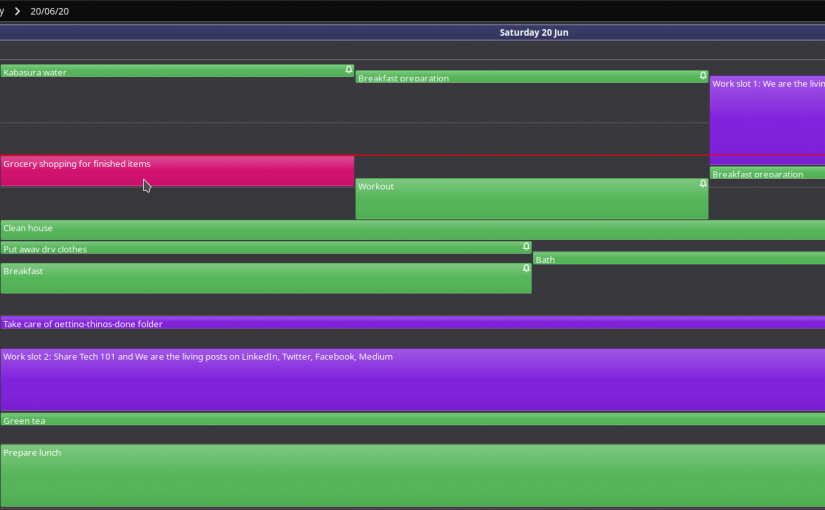Free time, drool! That wonderful chunk of time when we can do ANYTHING we want. Importantly, it as also the time when we DO NOT have to do what someone else expects us to do. But wait! We may not be doing what others require us to do. But are we really spending it on ourselves? Well, sadly we are giving up our free time not by working for someone else, but by following someone else’s story too deeply instead of our own, even if their story isn’t inspiring or important to our own progress. Continue reading How to invest 30 days in yourself
Category: Productivity
Momentum & Inertia: How to start things & get them done
In physics, we learn about a phenomenon called inertia. It means that a moving body continues to move at the same speed in the same direction or a stationary body continues to be stationary, unless someone does something to change that. Physicists have also framed a measurement system to measure the inertia of a body. This measurement is called the momentum. Putting a number to momentum is useful for letting us know just how much work must be done in order to make the body do something different than what it is doing now. However, for the purposes of English language, inertia and momentum are often used as opposites. The word inertia is used to describe a body not wanting to move and momentum describes a body not wanting to stop. The common ground for both is that they resist change.
How does this relate to human behaviour and getting things done? Turns out the human body and mind also show signs of inertia and momentum. The human body does not like sudden changes in movement and the human mind does not like sudden changes in behaviour. We can use these two facts to our advantage to start things off and get them done. I also later discuss when NOT to use the effects of momentum, since in certain cases momentum can build behaviour like addiction and inflexibility. Continue reading Momentum & Inertia: How to start things & get them done
Power up with a rousing morning routine
Imagine the following scenario. You wake up in the morning with the alarm ringing in your ears. You know that you must leave for work in an hour or so. You brush quickly, take a bath and put together a quick breakfast, something minimal like a sandwich with jam and a quick cup of tea. The clock is ticking away and the rest of your morning is spent getting dressed as fast as you can and getting your office bag in order, while taking a few quick looks at your phone for new emails and updates. Finally you rush out of home hoping to catch your train / bus to work.
Now imagine that you wake up in the morning and spend a few moments to stretch and take a deep breath. You enjoy the view from your window and steadily start your next sequence of actions. You fix yourself a healthy breakfast rich in nutrients and have it slowly enjoying each flavour. You spend some lovely time with your loved ones. You take some time to work out, meditate and read a book. Then you get ready for the day. You transition from shut-eye sleep to complete wakefulness in small steps, fresh and ready to face the day. You become a healthier and better person day by day.
Which one of the above is you? Continue reading Power up with a rousing morning routine
The Four Phases of Successful Habit Building !!
You probably already know that building good habits is the shortcut to building success. Determination and Willpower are good traits. But they are fleeting and limited and to count on them for building a habit is like having Hope as a strategy.

Most people rely on their will power to stick to a new habit. No wonder new year resolutions don’t even last a few weeks. We have all set resolutions to get fit, study harder, spend more time with family, travel more, start a business and we clock another year without doing any of it.
How can we create and sustain change? How do we set our self up to succeed ? If will power does not work, then what works ?
Continue reading The Four Phases of Successful Habit Building !!
One simple idea to get things right
In his book The Checklist Manifesto, Boston based surgeon Dr. Atul Gawande mentions that failures occur due to the following reasons. The top three of them are:
- Lack of knowledge
- Lack of proficiency despite the knowledge
- Completely unforeseen circumstances.
But more than 90% of his best-selling selling book highlights the failure of the fourth kind. You may have complete knowledge about a subject, you may have gained enough fluency to be an expert and the task ahead of you is completely predictable and smooth. Yet you goof up, because you forgot a step by either not paying attention to it or because some other step distracted you. These are the mistakes that are the easiest to eliminate and yet they keep creeping up in our day-to-day work. In this post, we discuss why they occur and how to eliminate them.
Getting makers and managers to work together
Imagine this scene from your childhood. You have just built yourself two LEGO battle tankers. You are sprawled on the floor, firing imaginary shells into the air across the two tankers. You make noise as you fire … bang… crack! Your hero tanker has taken a few hits and is weak. Your enemy tanker is just two shells away from destruction. The suspense is building and you are totally in the zone, lining up your hero tanker’s barrel at the enemy tanker for two final shots.
But your mother calls you and says that lunch is ready. She is insistent that you eat it NOW! You say, ‘Just two minutes, mommy’. But she is adamant. She has a kitchen to clean up and dishes to do before she can start her next meal prep. You have to go RIGHT NOW or she will get angry. She reasons with you that you can have lunch and resume ‘LEGO tankers’. Sure you can do that. But you have been shaken off your zone — the total isolation of focus that gets you physically, mentally and emotionally involved in what you do.
In the modern nuclear family, your mom no longer tears you away from your zone. But, you are constantly ripped away from it by meetings, phone notifications, calls and people visiting your desk. In this post, let us talk about how workplaces should be designed around the two types of professional people: those who need to interact with others to get things done, i.e. the managers, and those who need isolation to work at their best, i.e. the makers.
Continue reading Getting makers and managers to work together
How a calendar trumps a to-do list to boost productivity
Ask yourself the question, “What activities do I want to complete today?”. You will most likely whip out a pen and paper to start listing all the things you want to get done today.
Hmm, so should I write the blog post for this week? What about my bathroom with its white tiles no longer looking white? Oh, I am out of sugar and unless I buy it, I cannot have tea with sugar this evening. That reminds me, I am out of milk too. I have to get it if I want to avoid having last-minute black tea. Okay, so in summary, I must write the blog post, clean the bathroom and buy milk and sugar. Okay, my to-do list is nicely mapped with a list of things I want to achieve today. Good job! Okay, let’s check Facebook now for just 10 minutes. Then I will get to my to-do list.
Soon, I realise that my Facebook checking has gone on for a couple of hours, followed by a link in one of the posts which took me on an endless spiral of hyperlink-chasing until…… tea time!!! Oops, I want tea and I don’t have sugar and milk. Goddammit, not bitter black tea again!!! I knew it… I need something better than just a to-do list to keep me focused!
There is something better. A calendar.
Continue reading How a calendar trumps a to-do list to boost productivity





